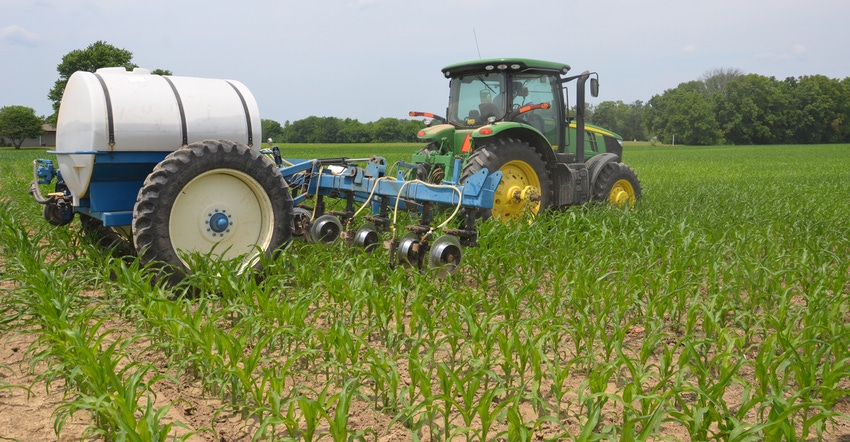
Suppose you applied 40 pounds per acre of nitrogen as starter following soybeans. You farm average land with some gentle slopes in some fields. How much more nitrogen should you apply this year? What decision tools are available to help me? Should it all go on as sidedress nitrogen?
Three Indiana certified crop advisers provide insight to help answer these questions. The CCAs include Betsy Bower, an agronomist with Ceres Solutions, Terre Haute, Jesse Grogan, a regional agronomy manager with AgReliant Genetics, Lafayette, and Stan Miles, an agronomist with A&L Great Lakes Labs, Fort Wayne.
How much nitrogen should you apply? Using an economic optimum nitrogen rate (EONR) calculator and pricing nitrogen at 40 cents per pound, and using a $3.50 per bushel corn price in a corn following soybeans rotation, Miles says your total seasonal nitrogen rate target would be about 175 pounds per acre. With 40 pounds applied at planting as starter, a recommendation of 135 pounds per acre as sidedress could be used as a starting point, he believes.
Adjustments should be made based on things like manure applications, field history, and if other nitrogen sources were applied, he continues. Miles notes that a soil nitrate test on a sample collected at a 12-inch depth at the V4 growth stage is a useful tool for fine-tuning sidedress rates. Most agronomists who evaluated this method when it first appeared in Indiana reported it was most useful where manure or another organic source of nitrogen was used.
What decision tools are available? Miles refers to a nitrogen rate calculator. Grogan says the nitrogen rate calculator organized for seven states, including Indiana, and prepared by Iowa State University is an option. Find it at cnrc.agron.iastate.edu. However, he prefers paying attention to recommendations prepared by Purdue University Extension agronomists Bob Nielsen and Jim Camberato after they conducted field-scale nitrogen rate trials in Indiana for more than a decade. Find their results at https://bit.ly/Nmgmtguidelinescorn. The agronomic optimum N rate referred to in these recommendations is used to maximize yields without regard to profit, Grogan notes. The EONRs are used to maximize dollar return from nitrogen cost and potential crop income. EONRs varied from 170 to 210 pounds of nitrogen per acre, depending on where you live in the state. “I’ve found these recommendations realistic for Indiana growers,” Grogan observes.
Should it all go on as sidedress nitrogen? “In most situations in Indiana, applying the rest of your nitrogen at sidedress is the most cost-effective,” Bower says. “You want corn to not want for nitrogen, as it determines rows around or length of row. So, a timely sidedress application accomplishes both.
“From all the tissue sampling I’ve done and all the late sidedress applications made due to wet conditions, I’m pretty conservative on getting nitrogen applied at the V4 to V5 stage, especially with 40 pounds per acre as starter. My experience with our recent weather favors more nitrogen in preplant applications, so that corn doesn’t want for nitrogen at V4 to V5 if you can’t get in until V6 to V8.”
Bower adds that if you irrigate, fertigation with nitrogen can be an excellent yield-enhancer. Finally, splitting the sidedress application into early and late trips can help, she adds. That assumes equipment and time aren’t stumbling blocks, and that it rains to move late-applied nitrogen into the soil.
About the Author(s)
You May Also Like




